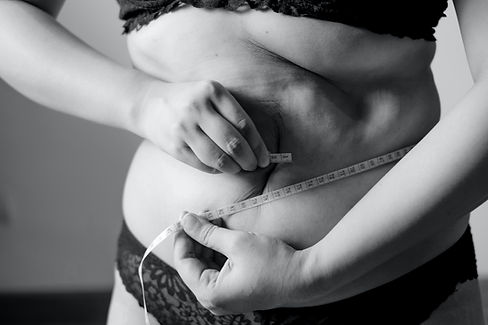Weight Loss in Beaverton
When we say "Weight Loss" what we really mean is "Body Composition Change", but that does not sound as catchy. The difference between the two is very important, though.
Weight loss simply means the number on the scale has gone down. That seems good to most people, even some doctors, but for us the type of tissue that is lost is more important than the number of pounds (or kilograms for you fancy folks) that are lost in the process. Why does it matter? Read on...


Adipose (fat) Tissue
Excess adipose tissue is pro-inflammatory, associated with poorer health, can reduce insulin sensitivity (promote progression toward pre-diabetes and diabetes), and is typically the tissue people want to lose when they talk about losing weight.
This is also the tissue we want our patients to lose during a weight loss journey with us. This tissue is tricky because if it is lost in an unhealthy manner it can grow back very easily.
Most people who have tried weight loss on their own have experienced rapid weight gain as soon as they stop their diet. Our goal is to get you to a place where your metabolism is robust and it can more easily keep you at your ideal weight.


Muscle Tissue
Healthy muscle tissue can improve insulin sensitivity which has anti-inflammatory effects, is associated with better health and reduced risk of frailty in older age, it keeps you moving and capable of doing the things you want to do, and it just plain looks good.
This is what we want to our patients to preserve during a weight loss journey with us. Additionally, muscle weighs more than fat, so if a person loses adipose tissue, and gains muscle they might weigh the same, or more, than they did at the beginning of their journey, but look fit, healthy, and trim. That is why focusing on "weight loss" does not make sense. This tissue, as opposed to adipose tissue, is easy to lose and much more difficult to build back. That is why it is paramount to do this the right way.
Bone Tissue
There was a very popular video going around social media not too long ago from a well known young lady who found out she developed osteopenia (lost enough bone mass that her bones had become weaker) after using GLP-1 medications for rapid weight loss.
What many people do not realize is that if they lose weight too rapidly, some of the weight they lose is bone mass. This is very concerning, especially for females, because it can be difficult to regain bone mass.
At Apricot Health Clinic, we prioritize a healthy approach to weight loss, so the risk of bone loss is greatly reduced.


Our Approach
Our goal is to help you achieve optimum health in a body you love. We do not crash diet our patients, or help them lose weight without considering their long-term health.
When people lose weight with calorie restriction alone, or worse, with calorie restriction plus lots of cardio and HIIT training, they experience metabolic adaptation that suppresses their metabolism. This primes their system to gain weight when they return to a normal diet and activity level. That can lead to a vicious cycle of gaining and losing weight. The really scary part is that each time they lose weight, they lose a significant amount of muscle mass, and when they gain weight back, they gain mostly adipose (fat) tissue back.
That process shifts the body's composition toward more adipose tissue and less muscle which can lead to more inflammation, poorer blood sugar control, and increased risk for frailty. It is the opposite of preparing a person for a long, health-filled, active, vibrant life.
Our approach includes everything from dietary guidance, exercise guidance, use of supplements, frequent body composition scans, and judicious use of GLP-1s (like semaglutide and tirzepatide) to help our patients reach their ideal body composition.
GLP-1s
Most people have heard of GLP-1s like semaglutide and tirzepatide by now and there is an absolute sand-storm of conflicting information available online. All those conflicting messages have many people scared to try GLP-1s.
At Apricot Health Clinic we understand that GLP-1s are a useful tool for many aspects of body composition change, but they are not a stand alone strategy. Additionally, we use customized dosing protocols that match our individual patients' unique needs rather than throwing a general one-size-fits-all approach at our patients.
We understand how to help patients reach their goals, while steering clear of most side effects and leaning into a great treatment response. Additionally, we work closely with our patients to help them avoid common pitfalls.
If a patient prefers to change their body composition without this tool, we are all for it. On the other hand, if a patient is someone that would benefit from GLP-1 use, our goal is to guide them through the process so they get the most out of it and minimize the associated risks.


What to Expect
First Visit:
During our first visit we review our patient's goals, find out about their past medical history, review any current labs they have brought to the appointment, discuss potential strategies for body composition change, and order labs for our patients. For patients who really want to take their health to the next level we offer comprehensive nutrition testing and other specialty testing as well. We also send the patient for their baseline body scan to assess their current body composition.
Second Visit:
During this visit we review lab results with the patient and discuss treatment options that best suite the patient. This includes dietary recommendations, physical activity recommendations, nutrient/supplement recommendations, and GLP-1 recommendations when reasonable.
Follow-Up Visits:
We have monthly follow-up visits with patients to help them navigate their process and stay on track. We recommend monthly body scans to track progress. Once we reach our goal we work on transitioning back to everyday life so our patients can truly enjoy their strong, healthy body into old age. After this we check in every 6-12 months as needed for ongoing support.
